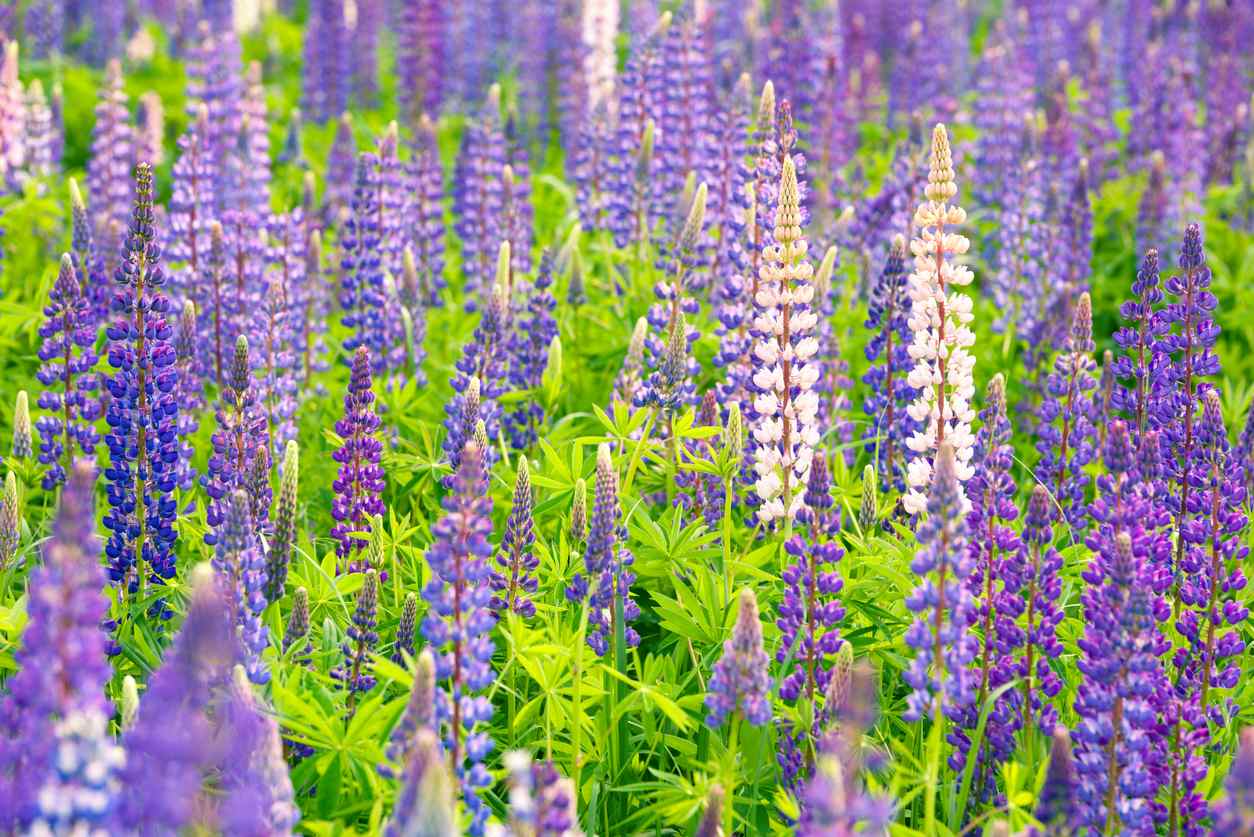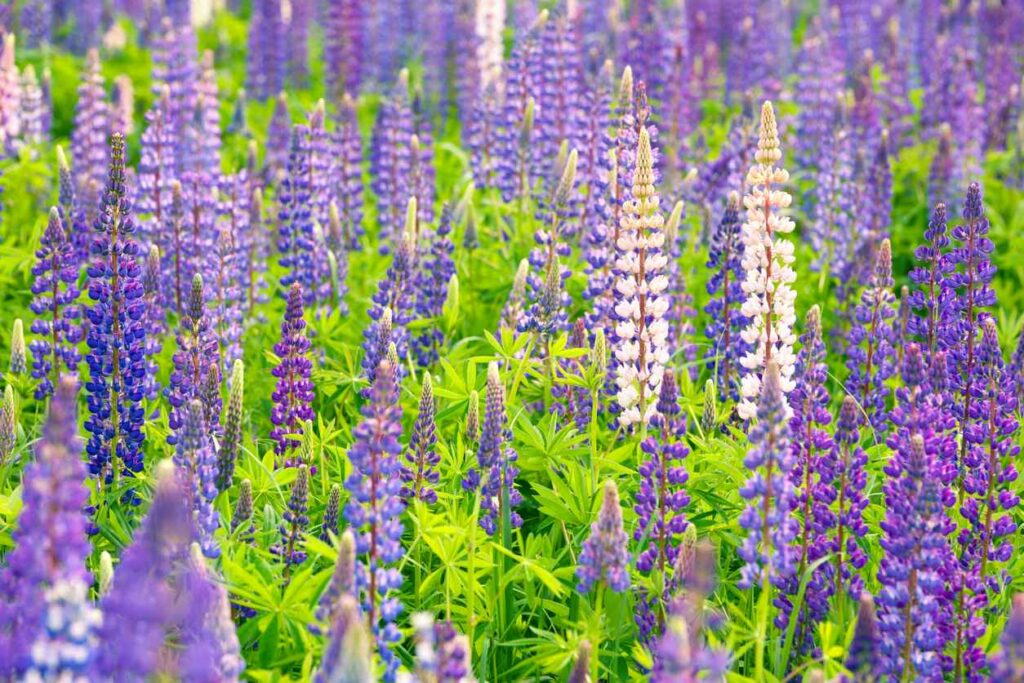Lupine Flowers Care – How To Grow Lupines
If you’re new to gardening, or you don’t take this hobby seriously, you might not have heard about lupine flowers. But then you see them in almost every garden, so how come you don’t have them? As every horticulturalist will tell you, lupines are more than ornamental plants. Their taproots are deep and nitrogen-packed so they fertilize the soil the longer they stay in your garden.
Not to mention that the beautiful lupine flowers attract bees and butterflies to your garden. These are natural pollinators that many perennials and annuals rely on to thrive and produce crops. And since lupines are easy to plant and they have fast growth rates. So what’s there not to like about them? This article covers everything you need to know about these extremely beneficial plants from the time you plant the seeds until you have blooming flowers in your garden.
Lupines at a Glance
Lupines (Lupinus) grow naturally in the wild and add a dash of vivid colors to the wilderness every spring. They are mainly herbaceous perennials but in some climates where the winter gets too cold, it’s better that you treat them as annuals. You can grow them indoors as well. Just make sure you pick a hybrid that doesn’t take up much space as we’ll see later.
Native to North America, lupines thrive in just about any soil and can handle the full sun or partial shade without a problem. With so many species and hybrids, their size varies between the modest one-foot plant to the giant 5-foot lupine. Since they are part of the legume family, they help enrich the soil with nitrogen. However, they are also toxic both for humans and pets so you need to be careful when handling them.
The flowers are the most stunning part of these perennials. They grow tall out of tubular spikes that tower over the foliage. The packed clusters of flowers come in many colors. They could be white, red, pink, purple, blue, yellow or they could have more than one color. New hybrids are always coming out every day with deeper and richer color combinations. They usually bloom in the spring or summer.
Overall lupines have USDA hardiness zones between 3 and 7 making them ideal for cool to moderate climates. However, you can grow them as houseplants where they will grow indoors year after year as perennials.
Lupine Varieties
Despite the fact that lupines come in a wide variety of species, experts were not satisfied. They wanted to improve the plant with new hybrids and cultivars that bloom longer and brighter. As a result, most nurseries are packed with some hybrids of every size and color. Here are some of the most popular lupine varieties to consider in your garden.
- Arroyo Lupine: A natural species that grows mainly in California. It has purplish flowers that bloom in the spring. However, it’s highly toxic so you have to handle it with care and keep it away from pets and children.
- Arctic Lupine: A cultivar that is more accustomed to Alaskan weather conditions. The flowers are either blue or purple. It grows well even in poor soil and enriches it with nitrogen with its taproots.
- Riverbank Lupine: A popular variety that dazzles with its natural beauty and bright flowers. It also has many benefits and practical uses. It restores nitrogen in depleted soil, prevents soil erosion, and has a strong fragrance. If you want to choose only one lupine, this is the one.
- Blue Pod Lupine: A tall and elegant cultivar that gardeners love to grow outdoors. Many lupine hybrids come from this cultivar although they usually have better flowers and deeper colors.
- Texas Bluebonnet: Bluebonnet is another name for lupines. However, this particular species has special protection in Texas. It’s the state flower and you’re not allowed to pick the flowers in the wild or harm them in any way. You can grow them in your garden of course. They have blue-purple colors and are easy to grow.
- Russell Lupine Mix: This species grows to about 3 feet tall and the flowers bloom in various colors. The interesting thing about this variety is that when you buy the seeds, you can’t tell what the plants will be like. So if you plant them in a group, you might end up with different lupines that all belong to this species.
How to Grow Lupines
For the most part, cultivars and hybrids are easier to grow and care for than the natural lupine species. They also have better blooms with different colors or even multi-colored flowers. This is why many gardeners prefer lupine cultivars. The easiest way to grow lupines is from seeds. Here’s how to plant them in easy steps.
- The best time to plant lupine seeds is in the spring after the last frost. Wait for the weather to warm up and the soil to become workable.
- Choose a location in your garden that gets the full sun.
- The soil needs to be well-drained, loose, and slightly acidic.
- Lupines prefer moist soil so you’ll need to keep that in mind when watering them.
- Make sure that the spot you pick for your lupines is a permanent one. These plants don’t transport easily.
- Till the soil before planting the seeds. Remove any weeds or debris and break the topsoil with a spade or a hoe.
- Mix organic materials with the top 6 inches of the soil and leave it in the sun for a few days.
- Give the lupine seeds the water test and get rid of any seeds that float in the bucket.
- Plant the seeds in holes about a quarter of an inch deep and cover with soil.
- Water the soil to make it wet. Keep the soil moist until the seeds germinate.
- It will take between two to four weeks for the seeds to germinate.
- When you have two leaves on the seedlings, thin them out keeping about 18 inches between each plant.
Lupine Care
Since lupines are native to North America and tolerate different weather and soil conditions, that makes them easy to maintain and care for. The only problem you might have is their toxicity. Again you should keep these ornamental lupines away from the reach of pets or humans. When you water them, always wear protective gloves. When pruning, always wear glasses as well to protect your eyes.
Soil
While lupines need a slightly acidic soil that is also well-drained, they can thrive in just about any soil. Even heavy soil will not stop these hardy perennials from growing. In many cases, you might grow them in a nitrogen-depleted patch in your garden to replenish it and make it fertile again. Thanks to their penetrating taproots, lupines favor sandy soil. If your garden is mainly clay, try to mix perlite, sand, or even gravel to improve drainage. Lupines don’t perform well when transported, so make sure you plant them in a permanent spot.
Watering
The hardy lupines don’t need much water but they prefer moist soil nonetheless. So make sure to give them the equivalent of one inch of rain once a week. That’s enough to keep the soil moist. In the summer months, cover the topsoil with a thick layer of mulch to improve water retention. Mulch will also help you fight off weeds that compete with the plants and stunt their growth. The plant’s watering needs will become less as the temperature drops. So hold off watering in the winter. Make sure the top three inches of the soil are dry before you water it.
Light
If you grow lupines as indoor plants, then it’s easy to provide adequate light conditions that ensure they grow healthy and robust. Outdoor plants, however, are a different story. Most hybrids and cultivars prefer full sun and need as many as 6 hours a day of sunlight. While you can still grow them in partial shade, the blooms tend to be less impressive. For those varieties are have fragrant flowers such as Riverbank Lupine, the scent will be less strong and the flowers may not bloom well without sunlight. Pick a spot in your garden facing the west or south to get the most of the sunlight.
Pests and Diseases
As we mentioned, lupines are toxic with some varieties more toxic than others. This is why neither deer nor rabbits come near the plants. However, other pests are immune to the lupine’s toxicity and feed on the leaves, stems, and even flowers. The most common pests are aphids, thrips, slugs, and lupine root weevils. The last two of these are the most destructive. Slugs feed on the leaves and cover the plants with their slime. As for lupine root weevils, they reside in the soil and feed on the roots of the plant. You’ll need to pick these pests by hand and dispose of them safely. Use protection whenever you touch lupines because of their toxicity.
In general, lupines suffer from four common diseases.
- Cucumber Mosaic Virus: A common disease carried by aphids. Symptoms include curled leaves, brown streaks on stems, and small leaves. The only way to deal with this disease is to remove all the infected plants and burn them.
- Botrytis: A fungal infection that covers the leaves, stems, and flowers with gray mold. High levels of humidity are the main cause of this disease. Avoid spraying water on the plants when you water them. Remove the infected parts of the plant. If the infection is widespread, remove the whole plant.
- Powdery Mildew: It affects the top side of the leaves and flowers. The mold is whitish and looks like powder. Humidity is the culprit here too. Keep the plants spaced out to improve air circulation and remove the infected plants.
- Downy Mildew: It starts at the underside of the leaves then creeps up to cover the surface with white patches. As with powdery mildew, make sure the plants are well spaced and get rid of the infected parts.

